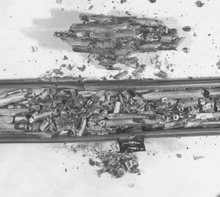The entire transcript may be viewed at:
http://www.nrc.gov/reading-rm/doc-collections/acrs/tr/subcommittee/2006/th120506.pdf
Going back to January 11, 2001, The ACRS issued a letter, Issues Associated With Industry-Developed Thermal-Hydraulics Codes. It is a lengthy tome with a very lengthy appendix.http://www.nrc.gov/reading-rm/doc-collections/acrs/letters/2001/4781926.html
The appendix includes the following section; I am quoting only the heading and the last sentence:
4. Codes have evolved, but the development process is hard to trace.
This situation supports the need for the staff to have its own code and to maintain a clear record of why design choices were made in its development.
Now, the TRACE racket has been proceeding under various guises for decades. Fortunes have been cast to the winds, not only in the software extravaganzas, but in the vast array of American as well as international test programs. The connections and relevance of the test programs to TRACE is obscure at best. The most recent disclosure of a link between testing and TRACE is from Staudenmeier in his slide presentation to the ACRS Thermal-Hydraulics Phenomenon Subcommittee on February 15, 2005. Two slides follow:

 The four test series in the slide above are a very small sample of the vast test programs that have been conducted, largely on the basis that they were needed for code development and proof testing. There is no mention of extensive LOFT and SPERT projects that were conducted decades ago at the presently named Idaho National Laboratory. This 2005 transcript may be viewed at:
The four test series in the slide above are a very small sample of the vast test programs that have been conducted, largely on the basis that they were needed for code development and proof testing. There is no mention of extensive LOFT and SPERT projects that were conducted decades ago at the presently named Idaho National Laboratory. This 2005 transcript may be viewed at:
http://www.nrc.gov/reading-rm/doc-collections/acrs/tr/subcommittee/2005/th021505.pdf
There is no mention of the "... more than 50 tests ..." that are discussed in my entry of February 20, 2007. Returning to that matter, here are some extractions from the NRC Memo that predates the Staudenmaier slide show by almost one year.
Memo to Matthews/Black-Technical Safety Analysis of PRM-50-76, A Petition for Rulemaking to Amend Appendix K to 10 CFR Part 50 and Regulatory Guide 1.157 - ML041210109. 18 pagesApril 29, 2004
Mr. Leyse states that:
“Petitioner is aware that more experiments with Zircaloy cladding have not been conducted on the scale necessary to . . . overcome the impression left from run 9573.”
In the above Memo, the NRC responded to its quote of Leyse as follows:
In the early 1980's, the NRC through Pacific Northwest Laboratories (PNL) contracted with National Research Universal (NRU) at Chalk River, Ontario, Canada to run a series of LOCA tests in the NRU reactor. More than 50 tests were conducted to evaluate the thermal-hydraulic and mechanical deformation behavior of a full length 32-rod nuclear bundle during the heatup, reflood and quench phases of a large break LOCA. Two tests were initially selected (References 17 and 18) for COBRA/TRAC (Reference 19) simulation to assess the applicability of that code. The NRC is reviewing the data from this program to determine the value of using it to assess the current generation of codes such as TRAC-M (Reference 20), now renamed TRACE.The full ACRS meets March 8, 9 and 10, 2007 and will include the preparation of several ACRS reports in open sessions. One of the reports is "TRACE Thermal-Hydraulic Analysis Code." It will be interesting to find out what ACRS thinks about this chaotic situation.










